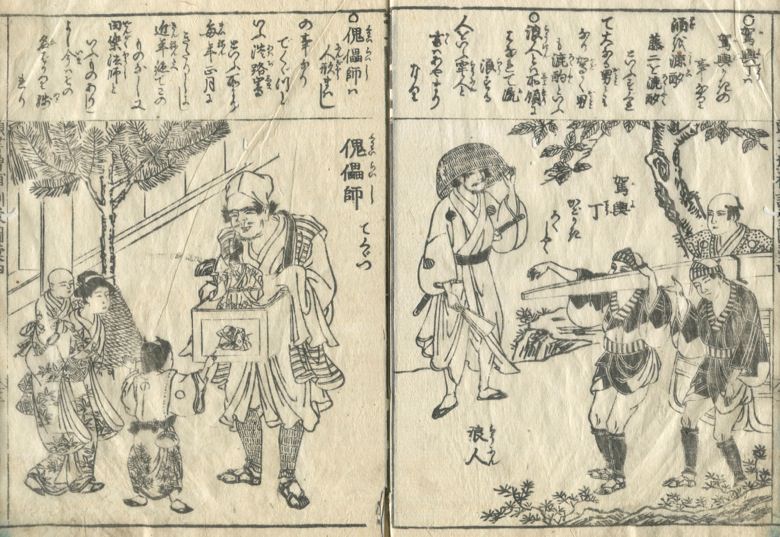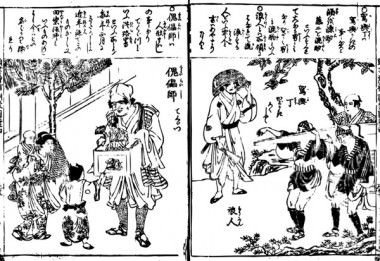“Those who shoulders a palanquin”, and a “Ronin” are drawn on the right.
“駕輿丁 (Kosikaki)” is those who shoulder “籠 (palanquin)” in which a noble person rides, and “輿 (Kosi).”
Although the next text could read the word to some extent, it was not able to translate a meaning.
In the investigated range, seemingly people who do various work including “駕輿丁” will be called “6 尺 (good provoking)”, those who work by a liquor maker as explanation of the “6 尺” will be called “漉酌 (rokusyaku)”, and it seems that the relation between this and “駕輿丁” is written and it is.
“Men of out of employment” is those who are wandering about by losing a feudal estate.
It is written that a “ronin” is a mistake.
People related to a noble person and the vagrant person who lost the country are drawn on one picture, and it is an interesting picture.
The puppeteer is drawn on the left.
“a puppeteer” is “a doll belt.”
It is said that it announced to the New Year in Awaji-shima every year.
it seems that moreover, it was working also as “dengaku Hoshi” who performs music and the “dengaku” which is traditional performing arts of a dance
With a picture, I show the child the puppet play and can hear about the fineness of structure of the doll.
右には籠の担ぎ手と浪人が描かれています。「駕輿丁(こしかき)」とは身分の高い人が乗る「籠(かご)」や「輿(こし)」を担ぐ人のことです。後の文章は単語はある程度読めるのですが意味が訳せませんでした。調べた範囲では、「駕輿丁」を含めていろいろな作業をする人々を「六尺(ろくしゃく)」といい、その「六尺」の説明として造り酒屋で働く人を「漉酌(ろくしゃく)」というそうで、これと「駕輿丁」の関係が書かれていいると思われます。「浪人(ろうにん)」とは所領を無くして流浪をしている人です。「牢人(ろうにん)」というのは間違いであると書かれています。一枚の絵に身分の高い人に関係する人々と、国を無くした流浪の人が描かれていて、興味深い絵です。
左には傀儡師が描かれています。「傀儡師(くぐつし/かいらいし)」とは「人形まわし(にんぎょうまわし)」のことです。淡路島では毎年正月に披露していたそうです。また、音楽と踊りの伝統芸能である「田楽(でんがく)」を行う「田楽法師(でんがくほうし)」としても活動していたようです。絵では子供に操り人形を見せていて、その人形の作りの細かさが伺えます。

